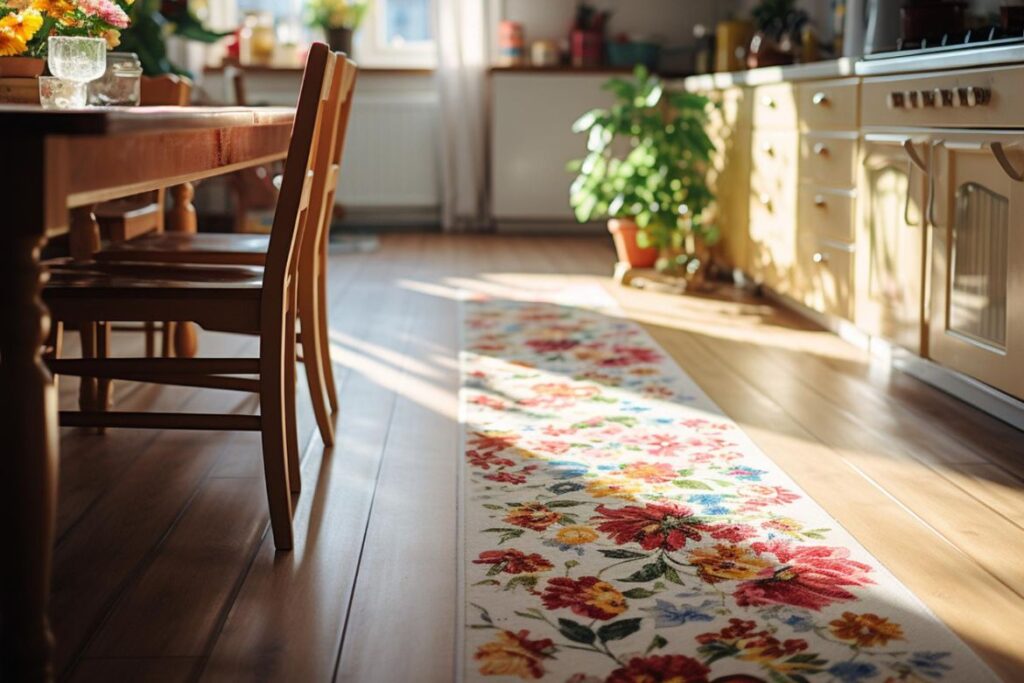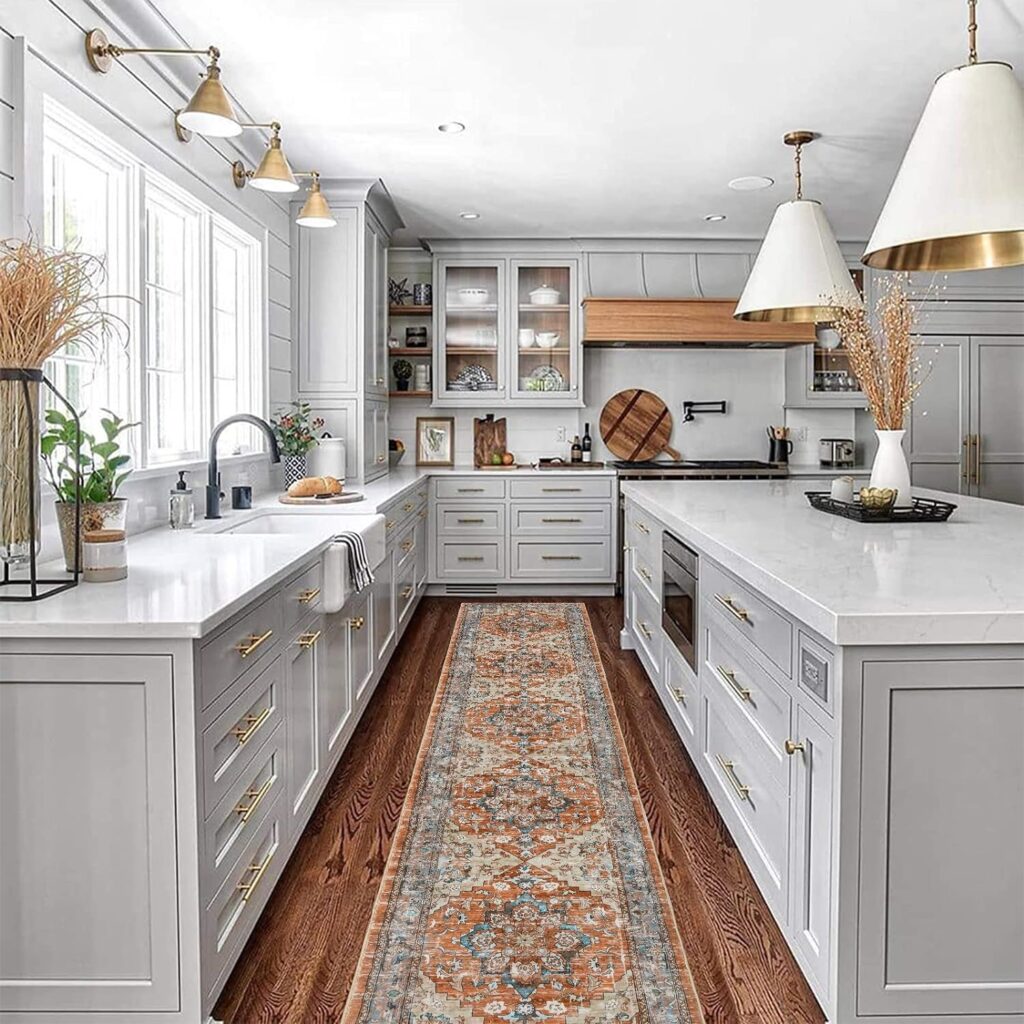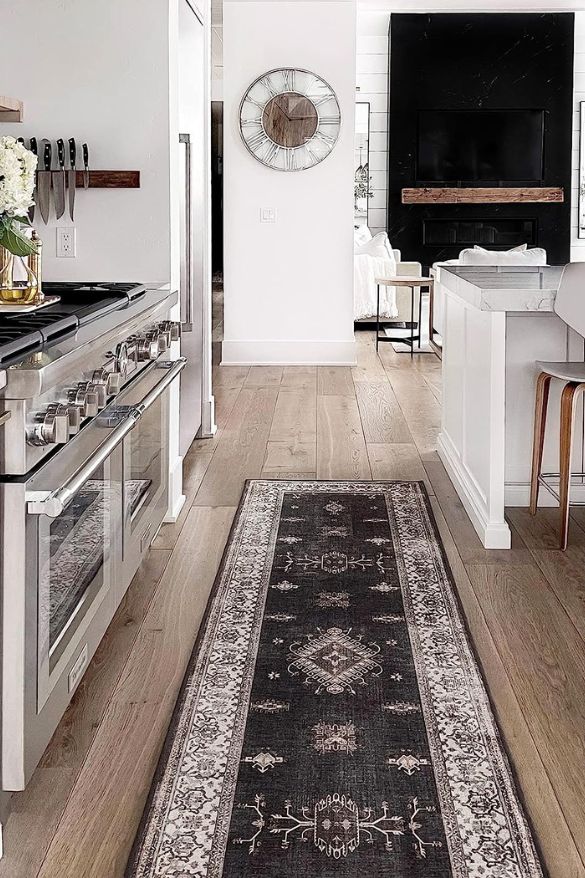Welcome to our guide on selecting the perfect kitchen runner rug! These stylish yet practical additions are more than just floor coverings; they’re a fusion of functionality and flair for your kitchen space. Beyond protecting your floors, kitchen runner rugs inject warmth, personality, and color, transforming the heart of your home. Whether you’re looking to revamp your kitchen’s look or add a cozy touch, the proper runner rug can make all the difference. This guide will walk you through everything you need to know, from material choices to style tips, ensuring your kitchen not only looks great but also reflects your unique taste. Let’s dive in!

Why Kitchen Runner Rugs Are Essential
Kitchen runner rugs are an integral part of home decor, blending functionality with aesthetic appeal to enhance your kitchen’s overall look and feel. These rugs serve several crucial roles in one of the most frequented spaces in a home.
Firstly, they add a layer of warmth and comfort underfoot, especially in kitchens with hard flooring like tile or hardwood. Standing for prolonged periods while cooking or washing dishes can be hard on the feet and legs, and a runner rug provides a softer, more comfortable surface to stand on.
From a design perspective, kitchen runner rugs are powerful tools for adding personality and color to the kitchen. A well-chosen rug can infuse life and character in spaces often dominated by appliances and cabinetry. Whether you prefer a classic, rustic, or modern design, there’s a runner rug to suit every style.
They can be a focal point or a subtle addition to complement the existing decor, making them versatile choices for any kitchen layout.
In addition to aesthetics and comfort, kitchen runner rugs are practical. They protect your floors from spills, stains, and wear, especially in high-traffic areas.
This is particularly important in the kitchen, where spills and messes are commonplace. Opting for materials that are easy to clean and maintain, such as polypropylene or nylon, can make upkeep a breeze while still ensuring your space looks chic and inviting.
Another important aspect is safety. Kitchens are prone to spills, leading to slippery floors. Runner rugs with non-slip backings provide added traction, reducing the risk of slips and falls. It’s essential to choose rugs with a good grip or invest in a quality rug pad to ensure they stay firmly in place.
Lastly, runner rugs can visually elongate the space in a smaller or narrow kitchen, creating an illusion of a larger area. By strategically placing a runner rug, you can enhance the room’s dimensions, making your kitchen feel more spacious and open.
Key Considerations When Choosing a Kitchen Runner Rug
Selecting the right kitchen runner rug goes beyond just picking an appealing color or pattern; it’s about finding a rug that enhances your kitchen’s aesthetic while also meeting practical demands.
The material of the rug is a crucial consideration. Soft and often machine-washable, cotton rugs are convenient but may not be as durable as other materials. Natural fibers like sisal and jute add a rustic texture and durability, ideal for high-traffic areas.
Synthetic materials such as nylon, polyester, and polypropylene are excellent choices for their durability and ease of maintenance, resisting stains and not easily absorbing spills. Wool rugs offer natural dirt resistance and comfort but can be pricier.
The weave and pile of the rug are also important. A flat, dense weave is best suited for kitchen rugs. Low-pile or flatweave rugs, being easier to clean and more durable, are preferable in busy kitchen areas, as they’re less likely to trap dirt and crumbs and resist spills effectively. Medium-pile rugs can be used too, but they require more attention to clean.
In terms of thickness, thinner rugs generally work better in kitchens. They are easier to clean and pose fewer tripping hazards. While they might lack the plush feel of thicker rugs, their practicality in a spill-prone environment like the kitchen makes up for it. Adding a rug pad underneath can provide extra cushioning and prevent slipping.
Stain resistance is another key feature to look for. In kitchens, where spills are common, a stain-resistant rug can be a time-saver in cleaning and maintaining its appearance. Synthetic materials are often treated to enhance stain resistance, while natural materials like wool come with inherent stain-resistant qualities.
Size and placement are also important. In galley-style kitchens, a runner rug can be placed down the middle or to one side, covering a significant portion of the floor for balance without extending from edge to edge. The length can vary based on personal preference and kitchen size, extending the full length of the kitchen, aligning with an island, or partially covering a galley kitchen.
Lastly, the design and aesthetics of the rug should complement your kitchen’s style. Whether aiming for a modern, traditional, or eclectic look, the rug should integrate seamlessly with your kitchen’s color scheme and decor, acting as a statement piece for a splash of color or a subtle addition to the existing palette.
By considering these aspects, you can select a kitchen runner rug that enhances both the functionality and the style of your kitchen space, transforming it from a purely functional area into a stylish and comfortable part of your home.
Sizing and Placement Tips for Kitchen Runner Rugs
Selecting the right size and placement for your kitchen runner rug is essential for both its aesthetic appeal and practical functionality. The ideal width for kitchen runner rugs typically ranges from 2 to 3.5 feet, perfectly fitting between kitchen counters. Their length varies from 6 to 14 feet, accommodating different kitchen sizes and layouts. To achieve a balanced look, the rug should cover about two-thirds to three-quarters of the floor width, without appearing too small or overwhelming the space. It’s advisable to avoid placing the rug from edge to edge; instead, leave some floor visible around its borders for a well-proportioned appearance.
In terms of placement, for galley-style kitchens, situating the rug along the center aisle can create a neat, streamlined look. Alternatively, you might place it off-center or between the kitchen counter and an island, depending on your kitchen’s design. The rug should be positioned to facilitate easy movement and not block access to doorways or appliances.
Before making a purchase, it’s important to measure your available space to ensure the rug will fit well in your kitchen. This step not only aids in visualizing the rug’s placement but also assists in choosing the appropriate size. Resources like Rug Sizing Guides offer detailed guidance for measuring and selecting the right rug size, ensuring you make a well-informed decision.
By carefully considering these aspects of size and placement, you can choose a kitchen runner rug that not only elevates the style of your kitchen but also contributes to a more welcoming and functional environment.
Material Matters: Selecting the Right Rug for Your Kitchen
The choice of material for your kitchen runner rug is a crucial decision that affects both its functionality and aesthetic appeal in your kitchen. Cotton rugs, known for their softness and versatility, are available in a variety of designs and colors, adding a casual and comfortable feel to your kitchen. These rugs are often machine washable, offering convenience in cleaning. However, they tend to wear out more quickly than sturdier materials, particularly with frequent washing.
Natural fibers like sisal and jute bring a rugged, earthy texture to your kitchen. Their durability makes them well-suited for high-traffic areas, and their natural tones easily blend with various decor styles, lending a rustic charm to the space. Wool rugs are another excellent option, renowned for their durability and comfort. They are naturally resistant to dirt and provide a luxurious feel underfoot. Although wool rugs come with a higher price tag, their longevity and ease of maintenance justify the investment.
Synthetic materials such as nylon, polyester, and polypropylene are superb choices for kitchen environments. These materials are incredibly durable, easy to maintain, and ideally designed to resist stains, which is essential in the spill-prone setting of a kitchen.
In addition to the material, the weave and thickness of the rug play a significant role. A flat, dense weave, often found in low-pile or flatweave rugs, is preferable in a kitchen setting due to its ease of cleaning and durability under heavy foot traffic.
When choosing the material for your kitchen runner rug, it’s important to consider aspects like the amount of foot traffic, proximity to cooking areas, and your cleaning preferences. A deeper understanding of the different materials and their properties can be gained by exploring resources like a Rug Materials Guide. Making the right material choice ensures that your rug is not only aesthetically pleasing but also practical and well-suited to the specific needs of your kitchen.
Styling Your Kitchen with Runner Rugs
Styling your kitchen with the right runner rug is a delightful way to uplift the ambiance, merging functional utility with aesthetic allure. The secret lies in selecting a rug that not only complements but also potentially contrasts with your kitchen’s overall design theme. Modern kitchens come alive with bold patterns or minimalist designs, while traditional or rustic settings are well-suited to classic Persian or Oriental patterns. The rug should enhance or strikingly contrast with the kitchen’s color palette and style, adding depth to the decor.
The addition of a kitchen runner rug is a superb strategy for injecting vibrancy and warmth into your kitchen. Opting for bright or patterned rugs can break the monotony of neutral tones, introducing an element of interest and coziness. Textures brought in by the rug contribute further to the kitchen’s inviting atmosphere.
A well-placed rug can also serve as a focal point in the kitchen. Positioning it in a central location or an easily visible spot draws the eye and can make a statement. It’s important to balance the rug’s color, pattern, and size to ensure it stands out without overwhelming the space.
Beyond style, runner rugs bring an element of comfort to your kitchen. They offer a soft surface underfoot, which is especially appreciated when spending extended periods standing, such as during cooking. This addition can transform the cooking experience into a more enjoyable one.
Moreover, runner rugs serve a functional purpose beyond mere decoration. They are practical tools for protecting floors from spills and general wear. Selecting a rug that is easy to clean and durable enough to withstand regular kitchen traffic ensures both practicality and longevity.
In essence, a kitchen runner rug is not just a decorative item but a multifunctional element in kitchen design. Whether you’re aiming to add a pop of color, create a warm ambiance, or protect your flooring, the right rug can significantly enhance your kitchen space. The key to success lies in balancing practicality and personal style, ensuring the rug you choose perfectly complements your kitchen.
Maintenance and Care for Kitchen Runner Rugs
Proper maintenance and care are essential for preserving the appearance and longevity of your kitchen runner rugs. Given the high-traffic nature and frequent spills in the kitchen, selecting a rug that is easy to clean and maintain is crucial.
For rugs prone to spills, like those near the sink or prep area, opting for materials that are stain-resistant and machine washable can simplify cleaning. Materials such as cotton, nylon, and some synthetics offer the convenience of being tossed in the washer, making them ideal for busy kitchens.
Regular vacuuming is also vital to remove crumbs and dirt and should be part of your weekly cleaning routine.
When dealing with stains, immediate attention is key. Blot spills promptly with a clean, absorbent cloth to prevent them from setting in. For tougher stains, a mild detergent or a rug-specific cleaner can be used, but it’s important to follow the manufacturer’s instructions to avoid damaging the rug’s fibers or colors.
Rotating the rug occasionally can help ensure even wear, especially in kitchens where certain areas receive more foot traffic than others. This practice helps maintain a uniform look over time.
In addition to regular cleaning, consider taking your rug to a professional cleaner annually, especially if it’s made from materials like wool or sisal that require specialized care. This ensures a deeper cleaning and can help maintain the rug’s quality and appearance.
With the right care and attention, your kitchen runner rug can remain a vibrant and comfortable part of your kitchen décor for years to come. For more detailed care instructions based on different rug materials, resources like Rug Care and Maintenance Guide offer valuable tips and guidelines.
Top Picks: Recommended Kitchen Runner Rugs


In the realm of kitchen runner rugs, there’s a wealth of options that cater to various styles, needs, and budgets. To assist you in your selection, here are some top picks that stand out for their quality, style, and practicality.
For those seeking a blend of traditional and contemporary, the Kamran Coral Rug offers a Persian-inspired design with a modern twist. Its muted coral and blue hues, set against a neutral base, provide a subtle yet elegant pop of color to any kitchen. The rug’s artful distressing lends it a vintage charm, making it a perfect choice for those looking to add a touch of history to their modern space.
If modern elegance is more your style, the Blue Distressed Persian Runner Rug is an excellent choice. Available on platforms like Amazon, this rug features a sophisticated blend of ivory, grey, yellow, and blue, working harmoniously with its Persian-inspired design to add a touch of luxury to your kitchen.
For kitchens with a rustic or farmhouse aesthetic, the Modern Farmhouse Kitchen Runner Rug, available on Wayfair, is an ideal match. With warm hues of rust, brick, and navy, it instantly adds homeliness to any kitchen. Its Persian-inspired design is faded for a vintage look, while the polyester make ensures durability and ease of cleaning.
Another notable option is the Cambria Ruby Rug, inspired by traditional kilim textile designs. Its deep ruby red and intricate patterns add warmth and personality, perfect for those looking to infuse their kitchen with a worldly, well-traveled vibe.

Lastly, the Versatile Black and White Plaid Runner stands as a stylish statement piece. Its simple yet striking design fits well in both industrial and farmhouse-style kitchens, and its water-resistant feature makes it ideal for busy, spill-prone areas.
Each of these rugs has been chosen for its ability to complement a range of kitchen styles while offering durability and ease of maintenance – key factors in any kitchen setting. Explore these options to find the perfect runner rug that not only suits your kitchen’s aesthetic but also meets your functional needs.
Incorporating a kitchen runner rug into your home decor is more than just a style statement; it’s about adding functionality, comfort, and a personal touch to one of the most used spaces in your home.
Throughout this guide, we’ve explored various aspects of choosing the perfect kitchen runner rug – from material and maintenance to style and placement. The right rug can transform your kitchen from a purely utilitarian space to a warm and inviting area that reflects your personal style and enhances your daily life.
Remember, a kitchen runner rug is an investment in your home’s comfort and aesthetic. Whether you opt for a bold pattern to add vibrancy or a subtle design for a touch of elegance, your choice can make a significant impact on the overall feel of your kitchen.
Now that you’re equipped with the knowledge to choose the ideal kitchen runner rug, we invite you to take the next step. Browse through our recommended picks, visit local stores, or explore online retailers to find the rug that speaks to you.
Once you’ve made your selection, we’d love to see how you’ve styled your kitchen with your new runner rug. Share photos of your revamped kitchen space on social media using the hashtag #ChicKitchenRugs, and inspire others with your flair for home decor.
Don’t forget to tag us in your posts! Your feedback is invaluable to us. If you have any additional tips, favorite picks, or questions, feel free to leave a comment below or reach out to us. Let’s continue to share ideas and inspire each other to make our homes more beautiful, one rug at a time. Happy decorating!
Frequently Asked Questions
1. What materials are best for kitchen runner rugs?
The best materials for kitchen runner rugs are those that are durable, easy to clean, and resistant to stains. Popular choices include cotton for its washability, natural fibers like sisal or jute for durability, and synthetic materials like nylon and polypropylene for stain resistance.
2. How do I choose the right size kitchen runner rug?
Measure the space where you plan to place the rug. The ideal kitchen runner rug should be large enough to cover most of the walking area but leave some floor space visible around the edges. Typically, a width of 2 to 3.5 feet and a length of 6 to 14 feet work well.
3. Can kitchen runner rugs be machine-washed?
It depends on the material. Cotton runner rugs are often machine washable, making them a convenient option. For other materials, check the manufacturer’s care instructions.
4. How can I prevent my kitchen runner rug from slipping?
Use a non-slip rug pad underneath your runner rug. These pads provide extra grip and also add a layer of cushioning for comfort.
5. How often should I clean my kitchen runner rug?
Regular vacuuming is recommended at least once a week. For spills, clean immediately to prevent stains. Depending on usage and material, a deep clean or professional cleaning may be required annually.
